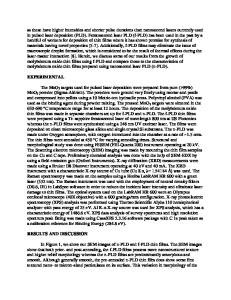Comparison of Vanadium Oxide Thin Films Prepared Using Femtosecond and Nanosecond Pulsed Laser Deposition
- PDF / 560,483 Bytes
- 6 Pages / 432 x 648 pts Page_size
- 10 Downloads / 379 Views
Comparison of Vanadium Oxide Thin Films Prepared Using Femtosecond and Nanosecond Pulsed Laser Deposition Ying Deng, Anthony Pelton, and R. A. Mayanovic Department of Physics, Astronomy & Materials Science, Missouri State University, Springfield, MO 65897, U.S.A. ABSTRACT Pulsed laser deposition (PLD) is a technique which utilizes a high energy pulsed laser ablation of targets to deposit thin films on substrates in a vacuum chamber. The high-intensity laser pulses create a plasma plume from the target material which is projected towards the substrate whereupon it condenses to deposit a thin film. Here we investigate the properties of vanadium oxide thin films prepared utilizing two variations of the pulsed laser deposition (PLD) technique: femtosecond PLD and nanosecond PLD. Femtosecond PLD (f-PLD) has a significantly higher peak intensity and shorter duration laser pulse compared to that of the excimer-based nanosecond PLD (n-PLD). Experiments have been conducted on the growth of thin films prepared from V2O5 targets on glass substrates using f-PLD and n-PLD. Characterization using SEM, XRD and Raman spectroscopy shows that the f-PLD films have significantly rougher texture prior to annealing and exhibit with an amorphous nano-crystalline character whereas the thin films grown using n-PLD are much smoother and highly predominantly amorphous. The surface morphology, structural, vibrational, and chemical- and electronic-state elemental properties of the vanadium oxide thin films, both prior to and after annealing to 450 °C, will be discussed. INTRODUCTION Transition metal oxides have attracted considerable attention in recent years due to their potential industrial applications. These compounds, including vanadium oxides, have wideranging physical properties that can be utilized in magneto-electronics, solid-state ionic, microelectronics, optoelectronics, and other applications. Vanadium pentoxide (V2O5) has been extensively studied due to its potential applications in electrochromic devices, cathode materials in Li-ion batteries, and optical devices [1,2]. Thin films play an important role in industrially useful applications. Pulsed laser deposition (PLD) is a thin film deposition technique well-known for its relatively simple setup, high deposition rates, low contamination, and control of stoichiometric ratios. The films deposited by PLD predominantly use nanosecond laser pulses (nanosecond- or n-PLD) in the UV regime, typically in the 193 to 355 nm range. Since femtosecond lasers, which have a significantly higher intensity and shorter pulse duration, have been introduced for utilizing in PLD, the femtosecond-PLD (f-PLD) technique has offered new prospects for thin-film deposition [3-5]. The high peak power and short pulse duration of a femtosecond laser pulse results in clean ablation of the target with minimal thermal damage to the ablated material. The irradiated region of the target does not lose energy during the short time so that the laser pulse is depositing energy in the material. The thermal energy depos
Data Loading...











